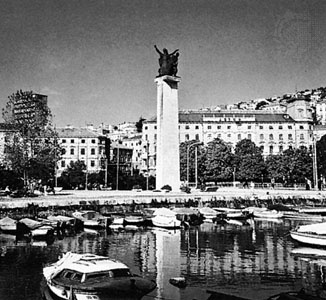Rijeka
Croatia
Italian Fiume,
 city, major port and industrial, commercial, and cultural centre of Croatia, located on the Kvarner (a gulf of the Adriatic Sea). It is the major port of Croatia. The city is situated on a narrow flatland between the Julian Alps and the Adriatic, spreading up the slopes and onto the landfills on the seafront. The name, dating from the 13th century, refers to the river called Rječina in Serbo-Croatian and Fiumara, or Eneo, in Italian. The port is a primary naval base and a point of departure for coastal shipping. The coastal section of the Adriatic Highway begins at Rijeka, which also has rail connections to Trieste, Ljubljana, and Zagreb. Shipyards and repair facilities, major oil refineries, a paper factory, and a diesel-engine works (in which in 1866 the English owner Robert Whitehead invented the torpedo) are industries of major importance.
city, major port and industrial, commercial, and cultural centre of Croatia, located on the Kvarner (a gulf of the Adriatic Sea). It is the major port of Croatia. The city is situated on a narrow flatland between the Julian Alps and the Adriatic, spreading up the slopes and onto the landfills on the seafront. The name, dating from the 13th century, refers to the river called Rječina in Serbo-Croatian and Fiumara, or Eneo, in Italian. The port is a primary naval base and a point of departure for coastal shipping. The coastal section of the Adriatic Highway begins at Rijeka, which also has rail connections to Trieste, Ljubljana, and Zagreb. Shipyards and repair facilities, major oil refineries, a paper factory, and a diesel-engine works (in which in 1866 the English owner Robert Whitehead invented the torpedo) are industries of major importance.A Roman settlement, Tarsatica, dating from the 3rd century, is thought to have been destroyed by Charlemagne about 800. Avars and Slavs had begun to settle there in the 6th–7th century, and a recognizable settlement (Starigrad, meaning “Old City”) had developed on the right bank of the Rječina by the 10th century. In 1471 it was incorporated into Austria, and it was made a free port in 1717, united to Croatia in 1776, and declared an autonomous city of the Hungarian crown in 1779. The French occupied it in the years 1809–14, after which the English expelled the French. Until after World War I, it was alternately under Austrian, Hungarian, and Croatian rule, during which period the buildup of the port and rail connections took place.
After 1918 Fiume-Rijeka became a major issue of the peace settlements. At first it was yielded to the new Yugoslav state, but it was returned to Italy in 1924 after Benito Mussolini assumed power, and the agreement for a free state was reneged upon. Yugoslavia retained the suburb of Sušak and certain port privileges, but the port declined under Italian management.
In 1943, during World War II, the Germans took over Rijeka, which suffered extensive damage from Allied air raids. In May 1945, the Yugoslavs liberated the city after heavy fighting, but not before the Germans had blown up port installations. Its postwar development was so extensive that expanded port facilities at Ploče and Bar are designed to provide relief for Rijeka.
Rijeka has many Baroque buildings, a 13th-century castle with later additions, several early churches (14th century), and a university (1973). The city is the terminus of an oil pipeline running from oil fields to the northeast. Pop. (2001) 143,800.
- Amy Lowell
- Amy Marcy Beach
- Amyntas III (or II)
- Amyot, Jacques
- amyotrophic lateral sclerosis
- Amy Tan
- Amy Vanderbilt
- Amália da Piedade Rebordão Rodrigues
- Amédée Ozenfant
- Amélie Mauresmo
- Américo Castro
- Amílcar Cabral
- Amānollāh Khan
- Amārah, Al-ʿ
- Amīnah al- Saʿīd
- Amīn, al-
- Amīn al- Ḥusaynī
- Amīr Khosrow
- Amīr ʿAbbas Hoveyda
- Amūqʿ
- Anabaena
- Anabaptist
- Anabasis
- anabatic wind
- Ana Blandiana